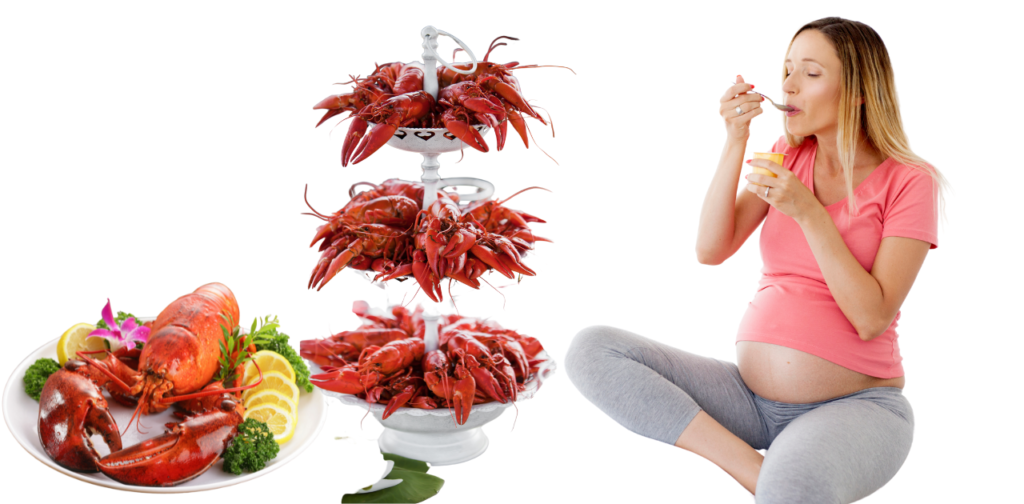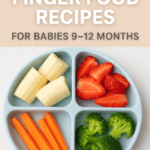When pregnant, making the right dietary choices is crucial for your health and your baby’s development. Seafood is often confusing for expecting mothers, with concerns ranging from mercury levels to bacterial contamination. Crawfish, a popular seafood delicacy in many regions, raises common questions for pregnant women: Is eating safe? What are the potential risks and benefits?
The good news is that crawfish are generally considered safe during pregnancy when appropriately cooked and consumed in moderation. As a low-mercury seafood option, the fish offer essential nutrients like high-quality protein, omega-3 fatty acids, and necessary vitamins like B12 and selenium, supporting maternal health and fetal development. However, critical safety tips include ensuring the crawfish are fully cooked and sourced from reputable places. This article will explore everything you need to know about enjoying crawfish during pregnancy, from safety guidelines to nutritional benefits.
What Are Crawfish?

Crawfish, also known as crayfish, crawdads, or freshwater lobsters, are small crustaceans that resemble miniature lobsters. They are commonly found in freshwater environments like rivers, swamps, and lakes, particularly in the southern United States. Crawfish are a staple in Southern cuisine, especially in Cajun and Creole cooking, where they are typically boiled with spices and served in large gatherings. Their sweet, tender meat is usually enjoyed in crawfish boils, étouffée, and bisque dishes.
Nutritional Benefits of Crawfish
Crawfish aren’t just tasty; they also pack a lot of nutritional value. They are a lean source of protein, which is essential for muscle growth and repair. Crawfish are also rich in vitamins and minerals like vitamin B12, which supports nerve function and red blood cell production, and selenium, an important antioxidant that helps protect cells from damage. Additionally, crawfish provide omega-3 fatty acids, which are beneficial for heart health and essential for the brain development of a growing baby during pregnancy.
The Common Concerns About Seafood During Pregnancy
Seafood can be a nutritious part of a pregnancy diet, but it often comes with specific concerns that make many expecting mothers hesitant. The main worries revolve around mercury levels, foodborne illnesses, and allergic reactions. Mercury is a toxic substance that, at high levels, can harm a developing baby’s brain and nervous system. This concern is most prevalent with certain fish like swordfish, sharks, and king mackerel, which are known to have high mercury content.
Another significant concern is the risk of foodborne illnesses such as listeriosis and toxoplasmosis, which can be caused by consuming undercooked or contaminated seafood. These infections can lead to severe complications during pregnancy, including miscarriage or preterm birth.
Allergies are another factor, especially if there is a history of shellfish allergies. Even if you haven’t had issues before, pregnancy can sometimes trigger new allergic responses.
Rea also : Is It Safe to Eat Bananas While Pregnant?
Risks of Consuming Seafood While Pregnant

While seafood offers many health benefits, certain risks are associated with eating it during pregnancy. The primary concerns include:
- Mercury Exposure: Some types of seafood contain high levels of mercury, a toxic metal that can harm a developing baby’s brain and nervous system. Fish like sharks, swordfish, and king mackerel are known to have elevated mercury levels, making them unsafe for pregnant women.
- Foodborne Illnesses: Consuming raw or undercooked seafood can lead to infections such as listeriosis and toxoplasmosis, which can cause severe complications during pregnancy. These infections may result in miscarriage, stillbirth, or premature delivery.
- Contaminants: Certain fish may be contaminated with pollutants like PCBs (polychlorinated biphenyls) or dioxins, which can negatively impact fetal development.
Guidelines Provided by Health Authorities
To reduce risks, health authorities like the FDA and EPA recommend the following guidelines for pregnant women:
- Choose Low-Mercury Seafood: Opt for fish like salmon, tilapia, shrimp, and crawfish, which are low in mercury and safe to eat during pregnancy.
- Limit Seafood Intake: Pregnant women are advised to consume 8-12 ounces (about 2-3 servings) of low-mercury seafood per week.
- Avoid High-Mercury Fish: Steer clear of high-mercury fish such as swordfish, king mackerel, and tilefish.
- Ensure Proper Cooking: Always eat fully cooked seafood to avoid the risk of foodborne illnesses. To be considered safe, cooked seafood should reach an internal temperature of 145°F (63°C).
Mercury Levels in Seafood
Mercury is a naturally occurring element that can accumulate in fish and seafood. High levels of mercury can be harmful, especially during pregnancy, as it can impact the development of a baby’s brain and nervous system. The amount of mercury in seafood varies depending on the species, with larger, longer-living fish tending to have the highest concentrations. Examples of fish with high mercury levels include sharks, swordfish, and king mackerel.
Importance of Low-Mercury Seafood
For pregnant women, choosing low-mercury seafood is essential. Low-mercury options provide the nutritional benefits of seafood, like omega-3 fatty acids, without posing a significant risk to fetal development. Including low-mercury seafood in your diet supports the baby’s brain and eye development while offering high-quality protein, vitamins, and minerals.
Where Crawfish Stand in Terms of Mercury Content
Crawfish are considered a low-mercury seafood option, making them one of the safer choices during pregnancy. Compared to larger fish, crawfish contain very low levels of mercury. This means that when properly cooked, crawfish can be safely enjoyed as part of a balanced diet for pregnant women. As always, it’s best to consume them in moderation and ensure they are sourced from clean, reputable environments.
Is It Safe to Eat Crawfish During Pregnancy?

Yes, it is generally safe to eat crawfish during pregnancy as long as certain precautions are taken. Crawfish are classified as low-mercury seafood, making them safer than high-mercury fish like swordfish or king mackerel. When fully cooked, crawfish are a nutritious source of lean protein, omega-3 fatty acids, and essential vitamins like B12, which benefit both mother and baby.
However, safety depends on proper preparation. Crawfish must be cooked thoroughly to eliminate harmful bacteria or parasites that could lead to foodborne illnesses like listeriosis. Undercooked or raw seafood poses significant risks during pregnancy and should be avoided. It’s also crucial to ensure that the crawfish are sourced from reputable places to reduce the risk of contamination.
Crawfish can be part of a balanced pregnancy diet in moderation and when cooked correctly. As always, it’s advisable to consult with your healthcare provider if you have any concerns about eating crawfish or other seafood during pregnancy.
Can Crawfish Cause Miscarriage?
Crawfish themselves are not directly linked to causing miscarriage. However, consuming undercooked or contaminated crawfish can lead to foodborne illnesses, such as listeriosis or toxoplasmosis, which can pose serious risks during pregnancy. These infections can potentially lead to complications like miscarriage, preterm labour, or stillbirth.
To minimize risk, ensure that crawfish are thoroughly cooked to an internal temperature of 145°F (63°C) and sourced from reputable suppliers. Following proper food safety practices allows you to enjoy crawfish without significantly increasing the risk of miscarriage.
Health Benefits of Eating Crawfish During Pregnancy
Eating crawfish during pregnancy can provide several health benefits, as they are packed with essential nutrients for maternal health and fetal development. Here are some key benefits:
- High-Quality Protein: Crawfish are an excellent source of lean protein, which is crucial for the growth and repair of tissues for the mother and the developing baby. Adequate protein intake supports muscle development and helps maintain overall energy levels.
- Rich in Omega-3 Fatty Acids: Omega-3 fatty acids are essential for brain and eye development in the fetus. Although crawfish contain lower levels of omega-3 compared to fatty fish like salmon, they still contribute to meeting this critical nutritional need.
- Vitamins and Minerals: Crawfish are rich in vitamin B12, vital for red blood cell formation and neurological function. They also provide selenium, a powerful antioxidant that helps protect cells from damage and supports the immune system.
- Low in Mercury: Crawfish are classified as low-mercury seafood, making them a safer choice for pregnant women. They can enjoy these health benefits without worrying about mercury exposure.
Risks Associated with Eating Crawfish During Pregnancy
While crawfish can be a nutritious part of a pregnancy diet, there are some risks to consider:
- Foodborne Illnesses: Consuming undercooked or raw crawfish can lead to illnesses like listeriosis or toxoplasmosis. These infections can cause serious complications, including miscarriage, preterm labour, or stillbirth. Ensuring that crawfish are thoroughly cooked to an internal temperature of 145°F (63°C) helps mitigate this risk.
- Contamination: Crawfish must be sourced from clean and reputable environments. Contaminated water sources can expose crawfish to harmful bacteria, parasites, or pollutants, posing risks to the mother and baby.
- Allergic Reactions: Eating crawfish can trigger allergic reactions ranging from mild symptoms to severe anaphylaxis if you have a shellfish allergy. If you have a known allergy to shellfish, it’s best to avoid crawfish altogether.
- Overconsumption: While crawfish are low in mercury, consuming them in moderation is essential to maintain a balanced diet. Excessive seafood consumption can lead to nutrient imbalances and potentially other health issues.
How to Safely Eat Crawfish When Pregnant

To enjoy crawfish safely during pregnancy, follow these guidelines:
- Ensure Thorough Cooking: Always cook crawfish thoroughly to eliminate harmful bacteria or parasites. The internal temperature should reach 145°F (63°C). Avoid eating raw or undercooked crawfish, as they can carry pathogens that pose risks during pregnancy.
- Source from Reputable Suppliers: Purchase crawfish from reputable sources that ensure their fresh seafood is sourced from clean, safe environments. This helps reduce the risk of contamination.
- Practice Good Hygiene: Before and after handling crawfish, wash your hands thoroughly with soap and water. Ensure that all cooking utensils, surfaces, and equipment are clean to prevent cross-contamination.
- Avoid High-Risk Preparations: Avoid clear dishes containing raw or partially cooked crawfish, such as crawfish salads or sushi. Instead, opt for fully-cooked recipes.
- Moderate Consumption: Even though crawfish are low in mercury, it’s still wise to consume them in moderation as part of a balanced diet. This helps maintain overall nutritional balance and reduces any potential risks associated with overconsumption.
How Much Crawfish is Safe to Eat?
When it comes to eating crawfish during pregnancy, moderation is key. While crawfish are a low-mercury seafood option, it’s crucial to follow general guidelines for seafood consumption to ensure a balanced diet and minimize potential risks. Here’s what you need to know:
- Recommended Portions: The general recommendation is to consume 8-12 ounces of low-mercury seafood per week, which equates to about 2-3 servings weekly. Crawfish can be included in this allowance.
- Serving Size: A typical serving of crawfish is about 3-4 ounces of cooked meat. If you enjoy a crawfish boil or similar dish, be mindful of portion sizes and avoid excessive consumption.
- Frequency: Incorporate crawfish into your diet occasionally rather than daily. This approach helps balance your seafood intake and ensures you receive various nutrients.
- Monitor Overall Intake: If you’re consuming other types of seafood, track your total seafood intake to stay within the recommended 8-12 ounces per week. This helps prevent overexposure to contaminants.
Alternative Seafood Options During Pregnancy
If you’re looking to diversify your seafood intake while staying within safe guidelines during pregnancy, here are some excellent low-mercury alternatives to consider:
- Salmon: Rich in omega-3 fatty acids and vitamin D, salmon is a nutritious choice. It’s also low in mercury, making it a safe option for pregnant women. Aim for wild-caught salmon if possible, as it typically has lower contaminants.
- Tilapia: This mild-flavoured fish is a good source of protein and is low in mercury. Tilapia can be a versatile addition to various dishes and is generally considered safe for pregnant women.
- Shrimp: Shrimp is low in mercury and provides essential nutrients like protein, vitamin B12, and selenium. It’s also quick and easy to prepare, making it a convenient seafood option.
- Cod: Another low-mercury fish, cod offers a lean source of protein and is rich in vitamins and minerals. It can be used in various recipes, from baked dishes to stews.
- Catfish: Catfish is low in mercury and provides good protein. It’s a popular choice in many recipes and can be a safe seafood option during pregnancy.
What If You Accidentally Eat Unsafe Crawfish?
If you accidentally consume unsafe crawfish, taking appropriate steps to protect your health and address potential risks is essential. Here’s what you should do:
- Monitor Symptoms: Pay attention to any signs of foodborne illness, such as nausea, vomiting, diarrhoea, abdominal pain, or fever. These symptoms can indicate an infection or food poisoning.
- Stay Hydrated: If you experience symptoms of foodborne illness, especially vomiting or diarrhoea, it’s crucial to stay hydrated. Drink plenty of fluids, such as water or oral rehydration solutions, to replace lost fluids and prevent dehydration.
- Seek Medical Attention: If you develop severe symptoms, such as persistent vomiting, high fever, severe abdominal pain, or signs of dehydration, contact your healthcare provider immediately. Pregnant women should be particularly cautious and seek medical advice promptly if they suspect a foodborne illness.
- Consult Your Healthcare Provider: Inform your healthcare provider about what you ate and any symptoms you’re experiencing. They can provide specific advice and, if necessary, recommend treatment or further evaluation.
- Follow-up: If your healthcare provider recommends any tests or treatments, follow them and keep them informed of any changes in your condition.
FAQ
How should I cook crawfish if I’m pregnant?
To ensure safety, cook crawfish until they reach an internal temperature of 145°F (63°C). Boil them thoroughly and avoid any raw or undercooked preparations. Proper cooking eliminates harmful bacteria and parasites that could cause foodborne illnesses.
Is it safe to eat crawfish boiled while pregnant?
Yes, a crawfish boil can be safe during pregnancy if the crawfish are fully cooked. Ensure all seafood in the boil reaches the appropriate temperature, and the preparation follows proper food safety practices.
How can I tell if the crawfish is fully cooked?
Fully cooked crawfish will be bright red, and the meat should be opaque and firm. If the meat is translucent or slimy, it is not fully cooked. Use a food thermometer to check that the internal temperature has reached 145°F (63°C).
What other seafood should I avoid during pregnancy?
Avoid high-mercury seafood like swordfish, shark, king mackerel, and tilefish. Also, avoid raw or undercooked seafood, such as sushi or ceviche, to reduce the risk of foodborne illnesses. Opt for low-mercury options like salmon, tilapia, and shrimp for a safer seafood experience.
Conclusion
Eating crawfish during pregnancy can be safe and nutritious when cooked thoroughly and consumed in moderation. They offer valuable protein, omega-3 fatty acids, and essential vitamins while being low in mercury. However, avoiding undercooked or contaminated the fish is crucial to prevent foodborne illnesses. By following safety guidelines and maintaining a balanced diet, you can enjoy the benefits of crawfish without compromising your health or your baby’s development. Always consult your healthcare provider if you have concerns or experience adverse symptoms.















